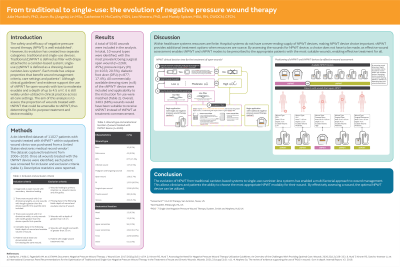Clinical Research
(CR-047) From Traditional to Single-Use: The Evolution of Negative Pressure Wound Therapy

The safety and efficacy of negative pressure wound therapy (NPWT) is well established1. However, its evolution has created two separate categories: traditional and single-use devices. Traditional (t)NPWT is defined as filler with drape attached to a canister-based system; single-use (s)NPWT is defined as a dressing-based canister-less system2. Each mode has unique properties that benefit wound management criteria, care settings and patients3. The aim of this analysis is to assess the proportion of wounds treated with tNPWT that could be amenable to sNPWT, thus determining fit-for-purpose treatment and device modality.
Methods:
A de-identified dataset of 11027 patients with wounds treated with tNPWT within outpatient wound clinics was purchased from a United States electronic medical record vendor. The dataset captured treatment from 2006-2020. Analysis was undertaken to determine the proportion of wounds that could have received sNPWT based on wound area, depth, exudate volume and sNPWT dressing size. Descriptive statistics were reported.
Results:
A total of 5040 wounds were included in the analysis. In total, 10 wound types were identified, with the most prevalent being surgical open wound (n=2268; 45%); pressure injury (n=1033; 20.5%); diabetic foot ulcer (n=877; 17.4%). All commercially available dressing sizes (n=8) of the sNPWT device were included and applicability to the instruction for use were matched. Overall, 3403 (68%) wounds would have been suitable to receive sNPWT instead of tNPWT at treatment commencement.
Discussion:
The utilization of tNPWT is ideally positioned for large, deep, highly exuding wounds with treatment continuing until wound closure or closure via skin graft. However, by assessing a wound’s dimensions and exudate volume, appropriate NPWT device selection can be made. This ensures a patient has been treated with a suitable device modality that is appropriate for their wound, while also protecting device availability.

.jpeg)